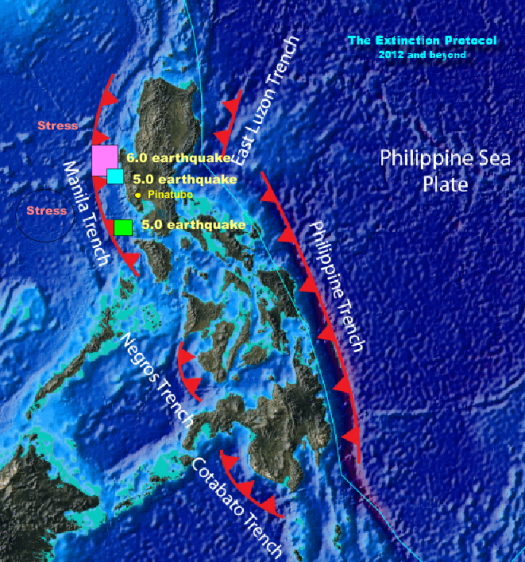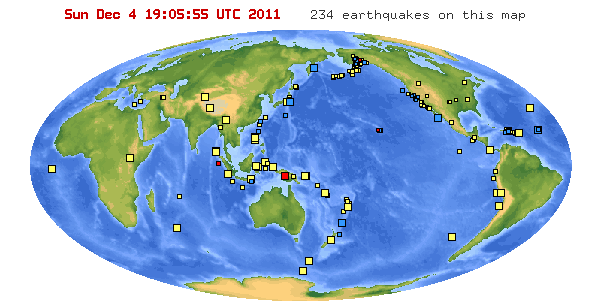http://timesofindia.indiatimes.com/india/Earthquake-rocks-Assam-Manipur-and-Nagaland/articleshow/10812528.cm
Myanmar shaken by 5.9 magnitude earthquake

 Re: The Earthquake/Seismic Activity Log
Re: The Earthquake/Seismic Activity Log
 Re: The Earthquake/Seismic Activity Log
Re: The Earthquake/Seismic Activity Log
 Re: The Earthquake/Seismic Activity Log
Re: The Earthquake/Seismic Activity Log
 Re: The Earthquake/Seismic Activity Log
Re: The Earthquake/Seismic Activity Log
 Re: The Earthquake/Seismic Activity Log
Re: The Earthquake/Seismic Activity Log
 Re: The Earthquake/Seismic Activity Log
Re: The Earthquake/Seismic Activity Log

 Re: The Earthquake/Seismic Activity Log
Re: The Earthquake/Seismic Activity Log
 Re: The Earthquake/Seismic Activity Log
Re: The Earthquake/Seismic Activity LogCarol wrote:Dealing with internal quakes tend to be a bit distracting Troy. You're slacking off boyo. Cracks whip ->

 Re: The Earthquake/Seismic Activity Log
Re: The Earthquake/Seismic Activity Log

 Re: The Earthquake/Seismic Activity Log
Re: The Earthquake/Seismic Activity Log
 Re: The Earthquake/Seismic Activity Log
Re: The Earthquake/Seismic Activity Log
 Re: The Earthquake/Seismic Activity Log
Re: The Earthquake/Seismic Activity Log
 Re: The Earthquake/Seismic Activity Log
Re: The Earthquake/Seismic Activity Loglindabaker wrote:Magnitude 2.1 - GEORGIA, USA
2011 December 04 06:55:21 UTC
Carol, I have been feeling mini quakes for the last two days. Even reported one a coupla days ago. Getting creaks and cracks in the house, too. After reading the post above, I checked USGS, and the one earlier today was this 2.1. This is significant change, because the East just hasn't had quakes before, and I'm as old as dirt. Gonna be 58 in less than two weeks. Quake activity is not I repeat not normal here and I think it is significant, just don't know how, yet.
Emergency Manager's Guide to Earthquakes in Georgia
Prepared for: Georgia Emergency Management Agency
February 1999
Prepared by: Leland Timothy Long
School of Earth and Atmospheric Sciences
Georgia Institute of Technology
Atlanta, Georgia 30332-0340
Introduction
When earthquakes are discussed, Georgia is not the first state to be mentioned. Earthquakes in Georgia are rare, particularly when they are compared to the long history of damaging earthquakes which are associated with California's active San Andrea fault zone and other fault zones bounding the tectonic plates of the Earth's crust. Movement of the Earth's crust along these plate boundaries explains most earthquakes. Georgia, like all the other states east of the Rocky Mountains, does not have active faults, and is not on a tectonic plate boundary. However, damaging earthquakes do occur in the interior of tectonic plates and these intraplate earthquakes can be an important consideration for emergency managers.
Earthquakes are less frequent in the eastern United States than in California. Consequently, fewer small earthquakes occur to remind us of the potential for damage from the less frequent great earthquakes. Never the less the historical record of earthquakes in Georgia (Figure 1) makes it clear that earthquakes and their associated seismic hazards exist. Damages from the great eastern United States earthquakes are largely forgotten because the last great earthquake was over 100 years ago. The 1886 Charleston, S.C., earthquake killed nearly 60 people and devastated the city. Although large earthquakes are less frequent, some seismologist argue that earthquakes cause damage over much larger areas in the eastern United States than earthquakes of similar size in the western United States. Also, the greater population density in the eastern United States increases the damage potential of eastern United States earthquakes over western United States earthquakes. Hence, in Georgia, as in most of the eastern United States, calculations of seismic hazard indicate that large distant earthquakes are likely to cause as much damage in Georgia as earthquakes of any size with epicenters within Georgia. For more details on the seismicity of the United States, see Slemmons et al. (1991).
READ MORE AT: http://quake.eas.gatech.edu/EMguide/EMguide.htm
Homeowner's Guide to Earthquake Hazards in Georgia
By, Leland Timothy Long
School of Earth and Atmospheric Sciences
Georgia Institute of Technology
Atlanta, Georgia 30332-0340
When earthquake hazards are discussed, Georgia is not the first state to be mentioned. Earthquakes in Georgia are rare compared to the long history of damaging earthquakes which are associated with California's active San Andreas Fault zone. Movements along active faults like the San Andreas explain 85% of the earthquakes in the world. The rest are scattered over areas like Georgia that lack clearly defined active faults. These scattered earthquakes in Georgia the eastern United States have caused significant damage and can be an important consideration for homeowners.
Because earthquakes are less frequent in the eastern United States than in California, we are not constantly reminded of our seismic hazard by frequent small earthquakes. Never-the-less the historical record of earthquakes in the southeastern United States and Georgia (figure 1) makes it clear that earthquakes and their associated seismic hazards exist. Damages from eastern United States earthquakes are largely forgotten because the last great earthquake was over 100 years ago. The 1886 Charleston, S.C., earthquake killed nearly 60 people and devastated the city. Also, some seismologist argue that while earthquakes in the eastern United States are less frequent, the large earthquakes cause damage over much larger areas and would affect more people than earthquakes of similar size in the western United States. In Georgia, calculations of seismic hazard indicate that large earthquakes outside our borders are as likely to cause damage in Georgia as earthquakes of any size occurring within Georgia.
The map of Georgia shows the location of all earthquakes that are known to have occurred within 25 km (15 mi.) of Georgia. The earthquakes across northwestern Georgia are part of the Southeastern Tennessee Seismic Zone (STSZ) that extends northeast through Knoxville. The STSZ lies primarily in the Valley and Ridge Province of the Southern Appalachians. Earthquakes in the STSZ are at depths of 14 ± 10 km and do not appear to be correlated with surface geology or near-surface faults. On the basis of seismicity, the STSZ is second only to the New Madrid Seismic Zone in the eastern United States for its size and rate of earthquake production. Earthquakes in the Blue Ridge and Piedmont Provinces occur in clusters with notable concentrations near reservoirs such as Lake Sinclair and Clarks Hill. They may occur any place that has unweathered and slightly fractured granitic rock near the surface. The small Piedmont earthquakes are unique in that they represent movements along shallow fractures that have been weakened, perhaps by penetrating fluids or weathering. Few earthquakes are known to occur in the Coastal Plane Province of South Georgia.
Small earthquakes are often no more alarming than the many vibrations that originate near or in a home, such as thunder, heavy trucks nearby, sonic booms, objects falling, and unbalanced washing machines. These all have unique characteristics that we learn to recognize through experience. Likewise, we can identify the small magnitude 2.0 or less earthquakes and explosions of a similar size by their unique characteristics. They usually start with a jolt, build rapidly in amplitude within a couple of seconds and then decay. The total felt duration of the typical small Georgia earthquake is usually less than 10 seconds and it sounds like a muffled dynamite explosion. Also, the rattling of loose objects may generate earthquake sounds. The typical small earthquake will be felt by many within 15km (10mi.) so that consultation with neighbors should eliminate most non earthquake sources within the home. The events in northern Georgia are 8 to 15 km deep and do not shake the surface as hard as the Piedmont earthquakes that are typically within 2.0 km of the surface. In the Piedmont, the earthquakes may occur as part of a 2 to 4 month long swarm, such as in the Norris Lake Community swarm of 1993. The time during a swarm is a good opportunity to eliminate hazards that could cause damage and injury during an earthquake, particularly because earthquake swarms are often followed by isolated events as large as the largest event in the swarm.
http://quake.eas.gatech.edu/Owners/OwnersGuide.htm
 Re: The Earthquake/Seismic Activity Log
Re: The Earthquake/Seismic Activity Log
 Re: The Earthquake/Seismic Activity Log
Re: The Earthquake/Seismic Activity Loglindabaker wrote:Thanks, Troy, great info. Hang in there!


 Re: The Earthquake/Seismic Activity Log
Re: The Earthquake/Seismic Activity Log
 Re: The Earthquake/Seismic Activity Log
Re: The Earthquake/Seismic Activity Log
 Re: The Earthquake/Seismic Activity Log
Re: The Earthquake/Seismic Activity Log
 Re: The Earthquake/Seismic Activity Log
Re: The Earthquake/Seismic Activity Log

 Re: The Earthquake/Seismic Activity Log
Re: The Earthquake/Seismic Activity Log
 Re: The Earthquake/Seismic Activity Log
Re: The Earthquake/Seismic Activity Log
 Re: The Earthquake/Seismic Activity Log
Re: The Earthquake/Seismic Activity LogEarthquake overview : The (extremely) shallow earthquake (USGS data) occurred along the northern Chile coast. Only a few villages are located in the direct epicenter area and are at risk during this earthquake. Locations like Huasco, Copiapo and Caldera will have felt the shaking. The difference in epicenter location and hypocenter leads to a theoretical difference in intensity from max. V (Chile) to VIII (USGS)
Thanks to Carlos Robles who joined us in searching information.
http://earthquake-report.com/2011/12/07/dangerous-shallow-earthquake-below-the-northern-chile-coast/

 Re: The Earthquake/Seismic Activity Log
Re: The Earthquake/Seismic Activity Log
 Re: The Earthquake/Seismic Activity Log
Re: The Earthquake/Seismic Activity Log
 Re: The Earthquake/Seismic Activity Log
Re: The Earthquake/Seismic Activity Log